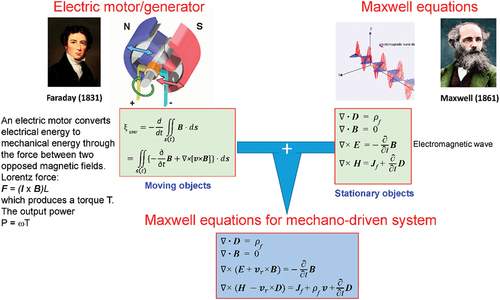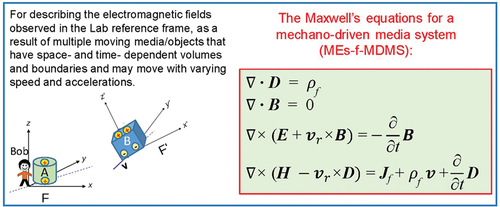Figures & data
Figure 1. Two approaches for dealing with the electrodynamics of moving medium. (a) Special relativity theory is about the experience of two independent observers, Bob and Alice, who are located in different reference frames (Lab frame S, Moving frame S’) that are relatively moving at a constant velocity and along a straight line. Bob and Alice observe the same electromagnetic phenomenon occurring in vacuum space, but with different measurement results. Such an approach is most effective for describing the electrodynamics in the universe. (b) Maxwell’s equations for a mechano-driven media system (MEs-f-MDMS) is about one observer who is observing two electromagnetic phenomena, which are associated with two moving objects/media located in the two reference frames that may relatively move at v << c. In general, the media/objects have sizes and boundaries, and they may move with acceleration along complex trajectories as driven by an external force. Such theory is most effective for engineering applications, but it can go beyond. We need to point out that special relativity may not be easily adopted for describing the case shown in (b) due to the change in speed of light across medium boundary.
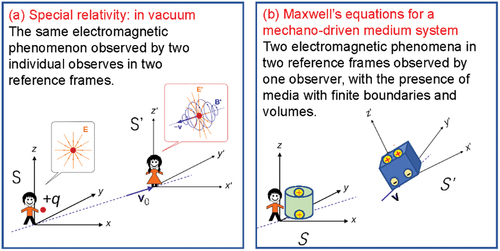
Figure 2. (a) Case for special relativity: Schematic diagram representing the general approach in special relativity, in which the fields observed by an observer who is moving at a constant velocity v about the fields (,
) that was first generated in the Lab frame (E, B). The Lorentz transformed relationships between the fields in the two reference frame in parallel to
and perpendicular to v are inset. (b) Mechano-driven moving media system in non-inertia frame: A general case in which the observer is on the ground frame (called Lab frame), with several media moving at complex velocities along various trajectories as represented by the dashed lines. The medium can translate, rotate, expand and even split. The co-moving frames for the media are: (x1, y1, z1), (x2, y2, z2). in such a case, the Lorentz transformation for special relativity cannot be easily applied, and the only realistic approach is to express all of the fields in the frame where the observation is done (Lab frame) and all of the fields are expressed in the variables in the Lab frame.

Figure 3. Several cases regarding to the flux rule for electromagnetic induction. (a): A typical example of thin wire circuit that is moving with acceleration with respect to the Lab frame in a time- and space- dependent magnetic field. (b): A conductive fan that is rotating inside a uniform magnetic field. (c) A rectangular thin wire circuit that is at stationary in a uniform magnetic field, but with one end sliding on the edge of a rotating conductive disc at t = 0 and t = t, and the other end is connected to the axis of the disc. The unit charge within the macroscopic size object can move, which leads to an additional term in the Faraday’s law for electromagnetic induction.
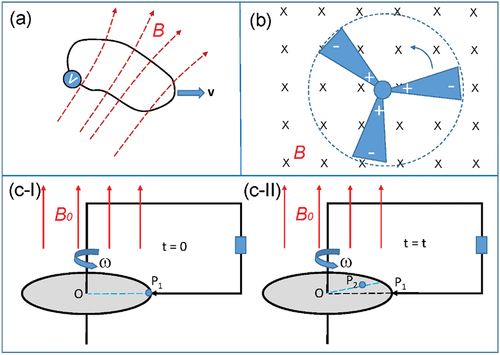
Figure 4. Schematic diagram showing an accelerated moving circuit that is made of thin wires (a), and the case if there is a large bulk piece of medium incepting the circuit (b), with the presence of magnetic field.
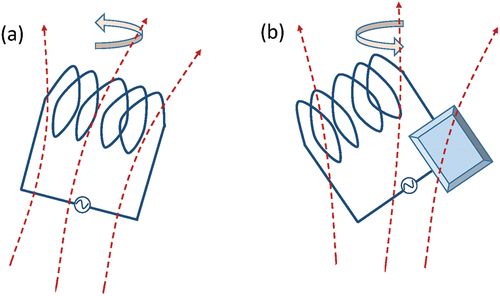
Figure 5. (a) Set up of the Röntgen and Eichenwald experiments. (b) Measurement of the convention current () that produces the same magnetic field as in (a). (c) Method of measuring the magnetic field produced by a polarization current represented by [
.
Reproduced with permission from Dover Publications [Citation23].
![Figure 5. (a) Set up of the Röntgen and Eichenwald experiments. (b) Measurement of the convention current (ρv) that produces the same magnetic field as in (a). (c) Method of measuring the magnetic field produced by a polarization current represented by [∇×(vr×D)+∂∂tD]. Reproduced with permission from Dover Publications [Citation23].](/cms/asset/b9bfcaf7-379f-4676-8aa2-51477c329213/tapx_a_2354767_f0005_oc.jpg)
Figure 6. Schematic diagram showing the three terms in the newly defined displacement vector D, and their represented space charges in the diagram. The charge density corresponding to Ps is that from surface contact electrification effect in TENG. Reproduced with permission from Elsevier [Citation15].
![Figure 6. Schematic diagram showing the three terms in the newly defined displacement vector D, and their represented space charges in the diagram. The charge density corresponding to Ps is that from surface contact electrification effect in TENG. Reproduced with permission from Elsevier [Citation15].](/cms/asset/7214438b-28d4-426c-b86d-58d92337c2f7/tapx_a_2354767_f0006_oc.jpg)
Figure 7. We use a flying disc to illustrate the applications of the MEs-f-MDMS for engineering purposes. The electromagnetic behavior inside the medium (the moving disc) is the MEs-f-MDMS, while that in vacuum is the classical MEs; the solutions of the two sets of equations meet the boundary conditions at the medium interfaces/surface. v(t) is the moving velocity of the origin of the S’ reference frame; vr(r,t) is the relative movement velocity of the object in the moving reference frame; Ps is the polarization introduced due to the relative movement of the objects in the moving reference frame if there are more objects to be considered.
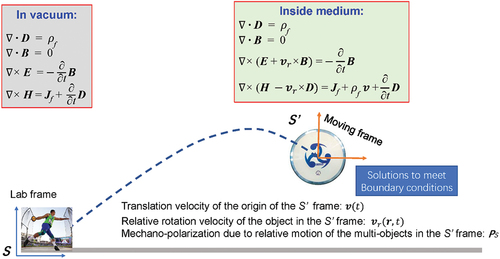
Figure 8. Schematic diagram showing an approximated method for decompose a non-inertia movement as a movement in an inertia frame plus a correction in non-inertia frame.
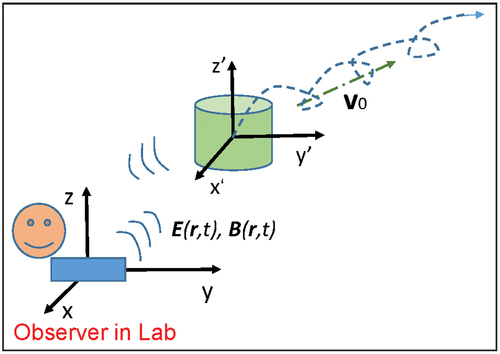
Figure 9. Two fundamental different approaches for developing the electrodynamics of a moving media system: special relativity through the Lorentz transformation for electromagnetic phenomena of point charges in vacuum space; the MEs-f-MDMS directly derived from the integral forms of the four physics laws in Galilean space and time, for the case of moving media with specific sizes and shapes and even acceleration. This is probably the most effective approach for engineering applications.
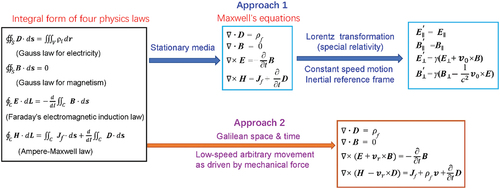
Figure 10. In the reference frame where Bob sites, there is an object/medium that is moving with acceleration and rotation. (a) The equations used by Bob for describing the electromagnetic behavior are: the classical MWs equations in vacuum space; for the space inside the moving object, MEs-f-MDMS. (b), in the reference frame in which Alice is located that moves with the moving object, since the medium is stationary for Alice, the electromagnetic behavior to be used by Alice ae the MEs for the entire space. The full solutions of the equations inside and outside the medium have to satisfy the boundary conditions.
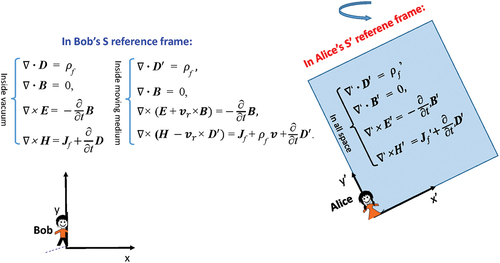
Figure 11. The MEs-f-MDMS are a unification of the theory for electromagnetic generator/motor and the theory of electromagnetic waves, so that the field in the entire space can be calculated. MEs-f-MDMS are likely to make a key difference in the regions near the moving objects, which may not be fully covered by the classical MEs. This is the contribution of the MEs-f-MDMS to the fundamentals of electrodynamics.
